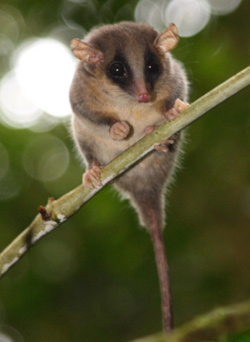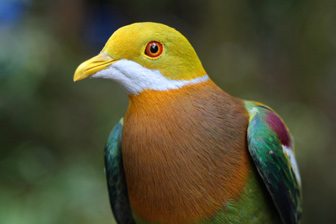
December 17, 2007

Martua Sinaga holds this 1.4 kg giant rat that is probably a species new to science. Photo by Bruce M Beehler
On Sunday night, December 16, 2007, the CBS program “60 Minutes” ran a segment on the research discoveries of Bruce M. Beehler in Indonesia’s remote Foja Mountains of western New Guinea.

The discovery of this so-called “lost world” was a media event earlier on February 7, 2007 (see here).

A probable new species of pygmy possum in the genus Cercartetus (Pygmy Possum). Photo by Bruce M Beehler
The earlier media treatments of the findings had gotten somewhat overblown (see discussion of that aspect of the “news” here), with seemingly claims of “hundreds of new species” being discovered.
Therefore, the “60 Minutes” segment was good to watch, to merely view the area and some animals of interest without too much “lost world” hype. The following article captures the essence of that reporting.

Ornate Fruit-Dove in Foja Mountains, western New Guinea, Indonesia. Photo by Bruce M Beehler
Two mammal species — a tiny possum and a giant rat — discovered on a recent expedition to Indonesia’s remote Foja Mountains in New Guinea are likely new to science, report researchers from Conservation International (CI) and Indonesia Institute of Science (LIPI). The area won international fame after a December 2005 survey turned up dozens of new species and gave urgency to conservation efforts in a region where logging and forest clearing for agriculture are a serious concern.
“It’s comforting to know that there is a place on earth so isolated that it remains the absolute realm of wild nature,” said CI Vice President Bruce Beehler, who led the expedition. “We were pleased to see that this little piece of Eden remains as pristine and enchanting as it was when we first visited.”
During the June 2007 expedition, the team documented two mammals, a Cercartetus pygmy possum, one of the world’s smallest marsupials, and a Mallomys giant rat, that appear to be new to science. The researchers also recorded the mating displays of several rare and little-known birds — including the golden-fronted bowerbird (Amblyornis flavifrons), the black sicklebill bird of paradise (Epimachus fastuosus), the Berlepsch’s six-wired bird of paradise (Parotia berlepschi), and the wattled smoky honeyeater (Melipotes carolae) — for the first time.
“The giant rat is about five times the size of a typical city rat,” said Kristofer Helgen, a scientist with the Smithsonian Institution in Washington, D.C. “With no fear of humans, it apparently came into the camp several times during the trip.”
According to CI, the Indonesian Government has declared the Foja Wilderness a National Wildlife Sanctuary and may seek carbon credits for protecting the forest area. Yesterday delegates at the U.N. climate meeting in Bali agreed that carbon-for-forest conservation initiatives should be developed and promoted as a way to cut greenhouse gas emissions. Globally, deforestation account for roughly 20 percent of anthropogenic climate-warming emissions.
CI and LIPI plan to return to the Foja Mountains in late 2008 or 2009 to survey the summit forests of the highest peak and the little-studied lower montane elevations where they expect to find additional unknown species of frogs, mammals, butterflies, and plants. The region was originally assessed under CI’s Rapid Assessment Program (RAP) which deploys expert scientists to poorly understood regions in order to quickly assess the biological diversity of an area. The conservation organization makes RAP results immediately available to local and international decision makers to help support conservation action and biodiversity protection.
“It’s as close to the Garden of Eden as you’re going to find on Earth,” said Bruce Beehler.
New Guinea’s forests are some of the most biodiverse in the world, but they are increasingly under threat from commercial logging. However, the Foja Mountains of western New Guinea are so isolated — in the furthest reaches of the Indonesian province of West Papua – they remain relatively untouched. In other parts of Indonesia poaching is taking a heavy toll on wildlife populations. “Photos: Two unknown mammal species discovered in ‘lost world'”, Mongabay.com, December 16, 2007.
About Loren Coleman
Loren Coleman is one of the world’s leading cryptozoologists, some say “the” leading living cryptozoologist. Certainly, he is acknowledged as the current living American researcher and writer who has most popularized cryptozoology in the late 20th and early 21st centuries.
Starting his fieldwork and investigations in 1960, after traveling and trekking extensively in pursuit of cryptozoological mysteries, Coleman began writing to share his experiences in 1969. An honorary member of Ivan T. Sanderson’s Society for the Investigation of the Unexplained in the 1970s, Coleman has been bestowed with similar honorary memberships of the North Idaho College Cryptozoology Club in 1983, and in subsequent years, that of the British Columbia Scientific Cryptozoology Club, CryptoSafari International, and other international organizations. He was also a Life Member and Benefactor of the International Society of Cryptozoology (now-defunct).
Loren Coleman’s daily blog, as a member of the Cryptomundo Team, served as an ongoing avenue of communication for the ever-growing body of cryptozoo news from 2005 through 2013. He returned as an infrequent contributor beginning Halloween week of 2015.
Coleman is the founder in 2003, and current director of the International Cryptozoology Museum in Portland, Maine.
Filed under Breaking News, Cryptotourism, CryptoZoo News, Cryptozoologists, Cryptozoology, Expedition Reports, Media Appearances, New Species, Photos